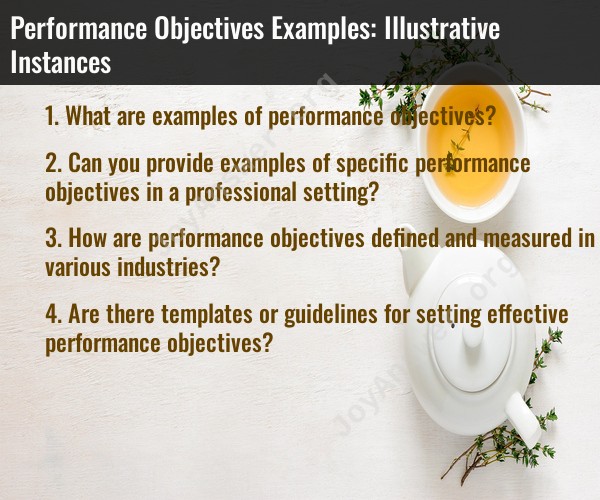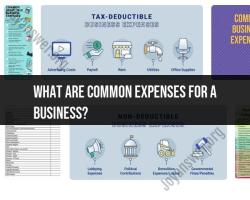What are examples of performance objectives?
Performance objectives are specific, measurable goals that employees set for themselves or that are set for them by their managers. These objectives help guide individual and team performance toward achieving overall organizational goals. Here are some examples of performance objectives across various areas:
Sales and Marketing:
Achieve a 20% Increase in Sales Revenue:
- Objective: Increase sales revenue by 20% compared to the previous quarter.
- Measurable Outcome: Quarterly sales reports showing a 20% or higher increase in revenue.
Secure 10 New Clients in the Next Quarter:
- Objective: Acquire 10 new clients within the next quarter.
- Measurable Outcome: Client acquisition records and reports demonstrating successful onboarding of 10 new clients.
Improve Customer Retention by 15%:
- Objective: Increase customer retention by 15% through improved customer service and loyalty programs.
- Measurable Outcome: Quarterly customer retention reports showing a 15% improvement.
Project Management:
Complete Project X Ahead of Schedule:
- Objective: Finish Project X two weeks before the deadline.
- Measurable Outcome: Project completion date compared to the original deadline.
Reduce Project Costs by 10%:
- Objective: Identify and implement cost-saving measures to reduce project expenses by 10%.
- Measurable Outcome: Cost analysis reports showing a 10% reduction in project expenses.
Human Resources:
Conduct Training Sessions for Team Development:
- Objective: Conduct monthly training sessions to enhance team skills and performance.
- Measurable Outcome: Attendance records, participant feedback, and improvements in team performance.
Reduce Employee Turnover by 20%:
- Objective: Implement strategies to decrease employee turnover by 20% in the next fiscal year.
- Measurable Outcome: Quarterly turnover reports reflecting a 20% decrease.
Customer Service:
Achieve a 95% Customer Satisfaction Rate:
- Objective: Attain a customer satisfaction rate of 95% or higher based on surveys and feedback.
- Measurable Outcome: Monthly customer satisfaction survey results.
Resolve Customer Complaints within 24 Hours:
- Objective: Address and resolve all customer complaints within 24 hours of receiving them.
- Measurable Outcome: Records of resolved complaints within the specified time frame.
Personal Development:
Complete Two Professional Development Courses This Year:
- Objective: Enroll in and complete two relevant professional development courses within the current calendar year.
- Measurable Outcome: Certificates of completion and enhanced skills applicable to the job.
Improve Time Management Skills:
- Objective: Reduce time spent on non-essential tasks by 20% through better time management practices.
- Measurable Outcome: Time logs and increased productivity.
Financial Objectives:
- Increase Profit Margins by 15%:
- Objective: Implement cost-saving measures and revenue optimization strategies to achieve a 15% increase in profit margins.
- Measurable Outcome: Quarterly financial reports reflecting a 15% or higher improvement in profit margins.
These examples demonstrate the specificity and measurability of performance objectives, which are key characteristics in effective goal-setting. When setting performance objectives, it's important to ensure they are SMART: Specific, Measurable, Achievable, Relevant, and Time-bound.
Examples of Specific Performance Objectives in a Professional SettingPerformance objectives are specific, measurable, achievable, relevant, and time-bound (SMART) goals that outline what an employee is expected to accomplish within a set period. Here are examples of specific performance objectives in various professional settings:
Sales:
- Increase sales by 15% in the next quarter.
- Close 10 new customer deals per month.
- Achieve a customer satisfaction rating of 95% or higher.
Marketing:
- Develop and implement a marketing campaign that generates 1000 qualified leads in the next six months.
- Increase website traffic by 20% in the next year.
- Improve brand awareness by 15% as measured by social media engagement.
Customer Service:
- Resolve customer inquiries within 24 hours.
- Maintain a customer satisfaction rating of 90% or higher.
- Reduce customer churn rate by 5% in the next year.
Finance:
- Prepare and submit accurate financial reports within deadlines.
- Reduce budget variances by 10% in the next fiscal year.
- Implement a new financial reporting system that improves efficiency by 20%.
Human Resources:
- Reduce employee turnover rate by 5% in the next year.
- Increase employee satisfaction by 10% as measured by employee surveys.
- Develop and implement a training program that improves employee productivity by 15%.
Performance Objective Definition and Measurement
The definition and measurement of performance objectives vary depending on the industry and the specific job role. However, there are some general guidelines that can be followed to ensure that objectives are SMART and effective.
Objectives should be specific: Objectives should be clearly defined and easily understood by both the employee and the manager.
Objectives should be measurable: Objectives should be quantifiable so that progress can be tracked and success can be evaluated.
Objectives should be achievable: Objectives should be challenging but realistic, taking into account the employee's skills, experience, and resources.
Objectives should be relevant: Objectives should be aligned with the overall goals of the organization and the employee's job role.
Objectives should be time-bound: Objectives should have a specific deadline for completion.
Templates and Guidelines for Setting Effective Performance Objectives
There are a number of templates and guidelines that can be used to set effective performance objectives. These resources can help managers and employees to define objectives that are clear, measurable, and achievable.
Some examples of templates and guidelines include:
- The SMART goals framework
- The OKR (Objectives and Key Results) framework
- The MBO (Management by Objectives) framework
These frameworks can be helpful in ensuring that performance objectives are well-defined and aligned with the overall goals of the organization.
In addition to using templates and guidelines, it is also important to involve employees in the process of setting performance objectives. This can help to ensure that employees are committed to achieving their goals and that they have the resources and support they need to succeed.
By following these general principles and using the available resources, managers and employees can work together to set effective performance objectives that lead to improved employee performance and organizational success.
I hope this helps! Let me know if you have any other questions.












